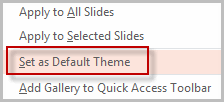You can download a sample presentation from my OneDrive here.
1 Use the effect options button on the ribbon
When launching your presentation it looks as if the two first options have the same effect. All the paragraphs are animated at the same time.
When you look at the animation in the animation pane you can see the difference. When you choose as one object there is only one animation, see the corresponding number next to the placeholder in your slide.
With the second option All at once there is one animation for every paragraph, but all animations except the first are formatted as with previous. Click the double arrow beneath the animation to make this visible. Next to every paragraph you see the same number.
But you can choose to apply a different effect to every paragraph or play with the animation timing and delay.
Below you can see an example using the float animation. The green boxes (advanced timeline) show that there is a delay between each paragraph.
The third option One by one is very clear, each paragraph is animated separately with a click of the mouse. See the numbers next to the placeholder in your slide.
2 Double click the animation in the animation pane, click the text animation tab
If you have several levels of text you can animate them by level.
Below is an example of a slide with a placeholder with two text levels.
The first screenshot is an example of 1st level animation. This means that both levels will appear when you click. See the numbers next to the placeholder.
The second screenshot is an example of 2nd level animation. Here you have to click once for every level.
When you use a text box you drew yourself the same options are available. The downside is that you need to format the text box before you can start animating it.
Attention!
If you want to animate different levels of text in a text box you drew yourself you need to choose the text level by clicking the increase level button in the paragraph section of the Home tab.
3 Double click the added animation in the animation pane, click the Effect tab in the dialog
Next to the animate text option you get three choices.
By default the whole paragraph is animated. But you can animate per letter or word. Personally I seldom use these possibilities. This article is dedicated to animating paragraphs so I will not discuss them here.























